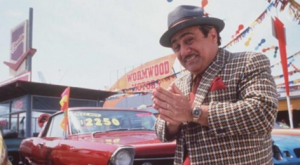Shopping for a car can be a tough experience indeed. You need to find something that will run well, look good and, most importantly, won’t cost an arm and a leg. Therefore, you need to be careful. I recently came across an article that discusses some of the biggest mistakes that car buyers make, and what you can do to avoid them.

Dealing with a car salesman like this one can seem frightening, but it’s a necessary step in buying a good car.
If you make any sort of major purchase, you should absolutely do your research first. Due to the Internet, this is a whole lot easier than it was 20 or even 10 years ago. There are reliable sites, such as edmunds.com, that supply plenty of information on car makes and models, reviews, pricing, rebates and incentives and even negotiating techniques. A lot of people also don’t know that dealerships tend to have an online reputation (whether positive or negative) that allows you to negotiate a price and make a deal remotely.
It’s important to not just shop at one dealership. When you’re out buying a car, you should check out at least three different dealerships. This isn’t something that you want to do in person, and thankfully, you don’t have to. Instead, you can use various review sites and dealership web sites to view vehicle inventory and you can ask about prices through the quote-request systems. You should compare deals and once you’re ready to buy, let the dealerships where you’re looking know that you’re still keeping your options open to help secure you a great price. And remember that it isn’t just about the money it’s important to choose a dealership you’re comfortable doing business with and you can trust.
Most buyers go into a car sale with a set amount that they’d like to pay for every month, and are more than happy to share that figure with the salesperson. However, when you do that, you’re not actually talking about the total price of the car. It’s also important to take into consideration the interest rate, in addition to the length of the loan. For example, a dealer might suggest a longer loan so that the car will fit into your budget, but a longer loan also means more interest, so that you’ll end up overpaying for the car.
If you’re planning on trading in an old car, make sure that you look up its value on your own. Once you do that, make sure that you print out the details and bring them with you to the dealership. If you don’t think that you’re getting a fair deal, you might be better off selling the car on your own, either to a private party or the used-car superstore CarMax. If your vehicle needs some minor work, it’s probably not worth fixing, since it won’t add much value to the trade-in.
As any farmer can tell you, you need to ride a horse before you buy it. The same goes for cars. That’s why the salesperson usually directs you where to go during a test-drive, but that doesn’t always give you a sense of how the car handles and how comfortable you are driving it. Buyers need to think about how they’re going to use the car on a daily basis: driving on the highway, transporting people under various conditions. The test-drive is also when you should check on visibility, how a car seat would fit into the back and if that third row is really that easy to get in and out of.
When you’re buying a new car, you need to look at the big picture, especially in regards to insurance. Many people let the dealership handle everything, but insurance agents often think about issues that buyers forget about. The dealer will pay for it, but you have to request it first.
Car salesmen can be some very untrustworthy people, and many people tend to buy cars from people that they don’t particularly like or trust, or even because they feel sorry for them. It’s important to remember that this is a business deal, and you need to come out on top. If a salesperson makes you feel uneasy for any reason, then walk away. The ideal salesperson can demonstrate the features of the car and help match a customer to the right car, so look for a salesperson who listens well and answers your questions directly.
Once you’ve negotiated a deal, and you’re headed to the finance and insurance, the sale isn’t over just yet. The F&I part of the sale is actually essential in the whole process, since it’s where the verbal promises made by the salesperson are finally put into the contract. It’s also where they try to sell you on extra things that wind up costing you more than previously thought.
One-stop shopping at the dealership might be convenient, but you should also look into financing with local banks or your credit union first. You should think about getting a pre-approval for a car loan before you even get to the dealership; you will know exactly how much you can afford to spend on the car, and you’ll know right away if the dealer can offer you a better deal on the interest rate.
The phrase “deal of a lifetime” gets thrown around an awful lot in the car lots, and salespeople tend to use it to pressure you into buying a car that day. But shopping for a car and driving away with that car the same day might not be a good idea. You have the right to sleep on a decision like that. And when you express hesitation, you’ll likely get a better deal later on.
